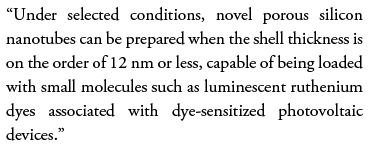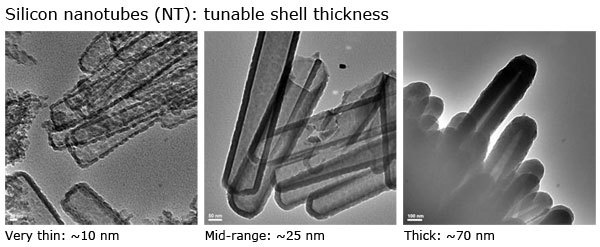Texas Christian University: Developing Silicon Nanotubes for Medicine and Electronics
While the path is well trod in carbon nanotube research and fabrication, silicon nanotube research is more akin to "the road not taken." But like the Robert Frost poem, the choice for silicon has "made all the difference" for
Chemistry Professor Jeffery Coffer at Texas Christian University. The direction was one he could hardly ignore, being located in the Silicon Prairie region of Texas.
Prior to 1991, as Asst. Professor in the Chemistry Department of TCU, he had been working with cadmium sulfide (a II-VI semiconductor) to create nanoparticles and nanocrystals. He recalls the day when, consulting with engineers at nearby Texas Instruments, his research took a different course.
"There was a manager in the silicon device lab at TI who said, 'If you want to get the attention of the semiconductor community you have to work on silicon,'" he explains. There was increasing interest in porous silicon and its potential for energy storage and nanodelivery, just what he was focused on in his lab. Since that time his work has evolved from thin films and particles to silicon nanowires and nanocrystals, and most recently silicon nanotubes for drug delivery and tissue engineering.
Silicon nanotubes are "elemental silicon, but hollow inside. We can make different inner diameters, wall thicknesses and make the walls porous as well. When you look at it there's a series of little parallel tubes. It has a more well-defined morphology and it can be tuned with greater control than other materials." He has succeeded in making these walls "uberthin with a 10nm shell."
While graphene and carbon nanotubes have been in the spotlight for the past decade, "the reality is silicon is still the mainstay of the electron device industry. Billions of dollars are spent on it every year, so I think it will continue very long time. Silicon is also the second most abundant element in the earth's crust. Silicon pays the bills, as I tell my graduate students."

Porous silicon has a network of cavities, "kind of like an anthill - it branches and is very complex. It has lot of positives but that also makes it difficult to characterize." The lab uses a
JEM-2100 LaB6 HR-TEM to investigate solid, crystalline, and amorphous structures. They also use an older model SEM, a JSM-6100, energy dispersive X-ray analysis (EDX), and confocal fluorescence/time-resolved microscopy. The equipment is a multi-department resource in the College of Science and Engineering at TCU. "We have strong support from our Dean in Science and Engineering. One of the things we pride ourselves in is student use of the instrumentation. While we have expert users, nobody who comes up and wants to use 2100 is turned away; we don't have a dedicated technician."

One new technique Coffer's lab is evaluating in the biomedical and therapy arena is a platform called magnetic assisted drug delivery, where a drug is added to a magnetic nanostructure, injected into the blood stream and a magnet is used to deliver the drug to a precise location. The technique came about because "nanoparticles are hard to keep herded together. We inject iron oxide nanocrystals into silicon nanotubes then you can drag them around with a magnet."
In addition to such biomedical applications, silicon nanotubes have real world applications in battery technology. "You can load a lot of lithium into the interior of a nanotube," he says. Coffer's team also has an interest in flexible electronics for personal diagnostics, which would mean development of a device coupled with a way to deliver drug, such as a smart patch. "It's tough to make silicon in that shape. We've looked at the fundamental properties of nanotubes and if we get them small enough they will actually dissolve. We think some of the biotech opportunities are very exciting."
Coffer's team published a paper in May entitled "Fabrication and Size Dependent Properties of Porous Silicon Nanotube Arrays" (Huang, Gonzalez-Rodriguez, Rich, Gryczynskib, Coffer; Chem. Commun., 2013, 49, 5760). His team consists of nine researchers.
Coffer is co-organizing a symposium (with Prof. Mike Sailor of UC San Diego) entitled "Silicon-based Inorganic Nanomaterials in Medicine" for the 2014 Fall National Meeting of the American Chemical Society in San Francisco. "The topic of this symposium is focused on nanomaterials, a research area that is experiencing exponential growth. Of course the nanomedicine field is currently dominated by soft materials such as polymers, micelles, liposomes, and protein or nucleic acid constructs. These materials find their roots in the organic chemistry or biochemistry communities. A unique aspect of the proposed symposium is that it will emphasize inorganic nanomaterials in biomedicine, in particular silicon-based nanomaterials. We hope this symposium will introduce this relatively new area to the chemistry community at large, and that it will also build bridges to the "soft" nanomaterials communities."
10 nm Magnetite nanoparticles inside Si NTs